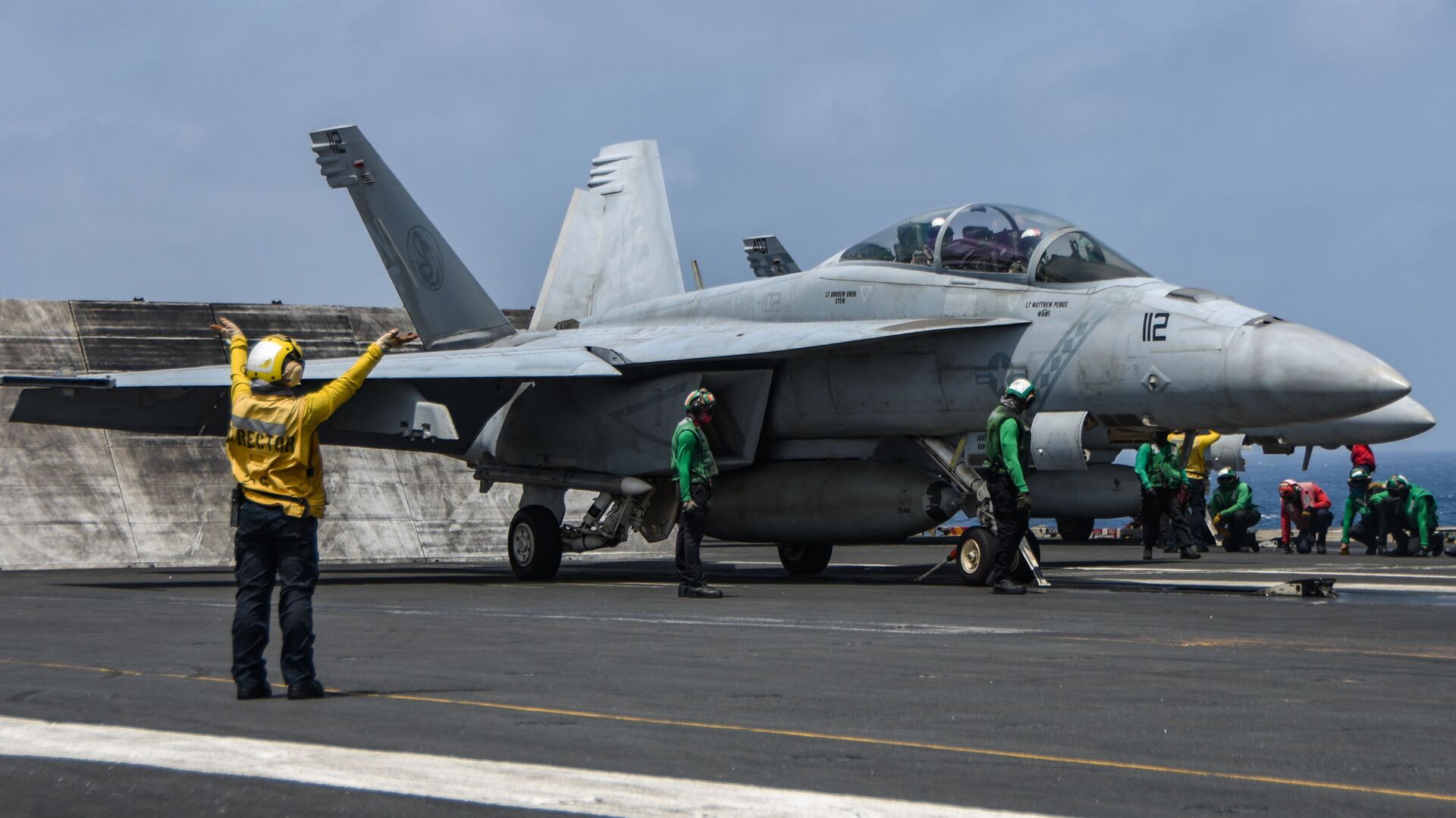https://sputnikglobe.com/20220711/us-navy-freak-storm-in-mediterranean-sends-fa-18-hornet-on-carrier-uss-truman-overboard-1097206606.html
US Navy: Freak Storm in Mediterranean Sends F/A-18 Hornet on Carrier USS Truman Overboard
US Navy: Freak Storm in Mediterranean Sends F/A-18 Hornet on Carrier USS Truman Overboard
Sputnik International
The US Navy has adopted the light and agile Hornet as its one-size-fits-all aircraft for naval aviation, retiring a number of older aircraft models and... 11.07.2022, Sputnik International
2022-07-11T23:38+0000
2022-07-11T23:38+0000
2022-10-19T20:03+0000
boeing f/a-18e/f super hornet
ionian sea
storm
us navy
https://cdn1.img.sputnikglobe.com/img/07e5/07/0d/1083380004_0:70:2102:1252_1920x0_80_0_0_dd2811c22b148c1e654a19292648c407.jpg
According to a US Navy release, the service recently lost one of its advanced F/A-18 Super Hornets to inclement weather in the Mediterranean Sea. However, the jet didn’t plunge from the skies, it simply slid off the flight deck of its aircraft carrier mothership.No one went overboard with the aircraft, the Navy said, but another sailor received minor injuries during the storm.The Navy didn’t say exactly where the incident occurred, but two days earlier, the Pentagon’s official Twitter account tweeted about the Truman’s mission by including an image of a Super Hornet breaking the sound barrier over the Ionian Sea. The waterway straddles the sea between Greece, Sicily, and southern Italy.According to maker Lockheed Martin, an F/A-18E Super Hornet weighs 32,000 pounds without fuel or weapons, but can weigh as much as 66,000 pounds when fully loaded. Still, despite its weight, the aircraft should’ve been stowed in the hangar below decks if inclement weather was coming, according to The Aviationist.“The contrast between temperatures at the ocean surface and high in the air might have created an exceptionally unstable atmosphere conducive for thunderstorms,” the paper wrote, noting that an intense type of downdraft called a microburst could have produced winds strong enough to produce lift under the fighter jet’s wings, picking it up and moving it.
ionian sea
Sputnik International
feedback@sputniknews.com
+74956456601
MIA „Rossiya Segodnya“
2022
Sputnik International
feedback@sputniknews.com
+74956456601
MIA „Rossiya Segodnya“
News
en_EN
Sputnik International
feedback@sputniknews.com
+74956456601
MIA „Rossiya Segodnya“
Sputnik International
feedback@sputniknews.com
+74956456601
MIA „Rossiya Segodnya“
boeing f/a-18e/f super hornet, ionian sea, storm, us navy
boeing f/a-18e/f super hornet, ionian sea, storm, us navy
US Navy: Freak Storm in Mediterranean Sends F/A-18 Hornet on Carrier USS Truman Overboard
23:38 GMT 11.07.2022 (Updated: 20:03 GMT 19.10.2022) The US Navy has adopted the light and agile Hornet as its one-size-fits-all aircraft for naval aviation, retiring a number of older aircraft models and modifying Hornets to fill their role, such as submarine hunting and electronics warfare. The newer Super Hornets can cost $67 million each.
According to a US Navy release, the service recently lost one of its advanced F/A-18 Super Hornets to inclement weather in the Mediterranean Sea. However, the jet didn’t plunge from the skies, it simply slid off the flight deck of its aircraft carrier mothership.
The Sunday statement, given from Naples, Italy, said the strike aircraft “blew overboard due to unexpected heavy weather,” but gave no further details. It noted a replenishment-at-sea operation then underway “was safely terminated through established procedures.”
No one went overboard with the aircraft, the Navy said, but another sailor received minor injuries during the storm.
The Navy didn’t say exactly where the incident occurred, but two days earlier, the Pentagon’s
official Twitter account tweeted about the Truman’s mission by including an image of a Super Hornet breaking the sound barrier over the Ionian Sea. The waterway straddles the sea between Greece, Sicily, and southern Italy.
The deepest chasm in the Ionian Sea - and of the Mediterranean - is some 17,280 feet deep and called Calypso Deep, off the coast of Pylos, Greece.
According to
maker Lockheed Martin, an F/A-18E Super Hornet weighs 32,000 pounds without fuel or weapons, but can weigh as much as 66,000 pounds when fully loaded. Still, despite its weight, the aircraft should’ve been stowed in the hangar below decks if inclement weather was coming,
according to The Aviationist.
The Washington Post noted on Monday that storms should’ve been anticipated, given atmospheric and sea conditions at the time, which included cold air moving in over abnormally warm seas.
“The contrast between temperatures at the ocean surface and high in the air might have created an exceptionally unstable atmosphere conducive for thunderstorms,” the paper wrote, noting that an intense type of downdraft called a microburst could have produced winds strong enough to produce lift under the fighter jet’s wings, picking it up and moving it.

